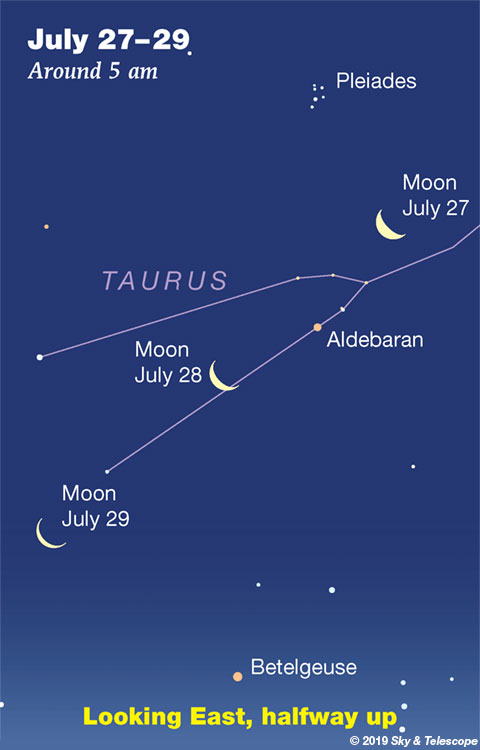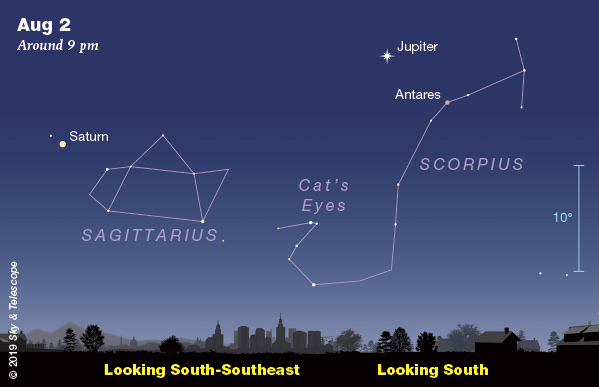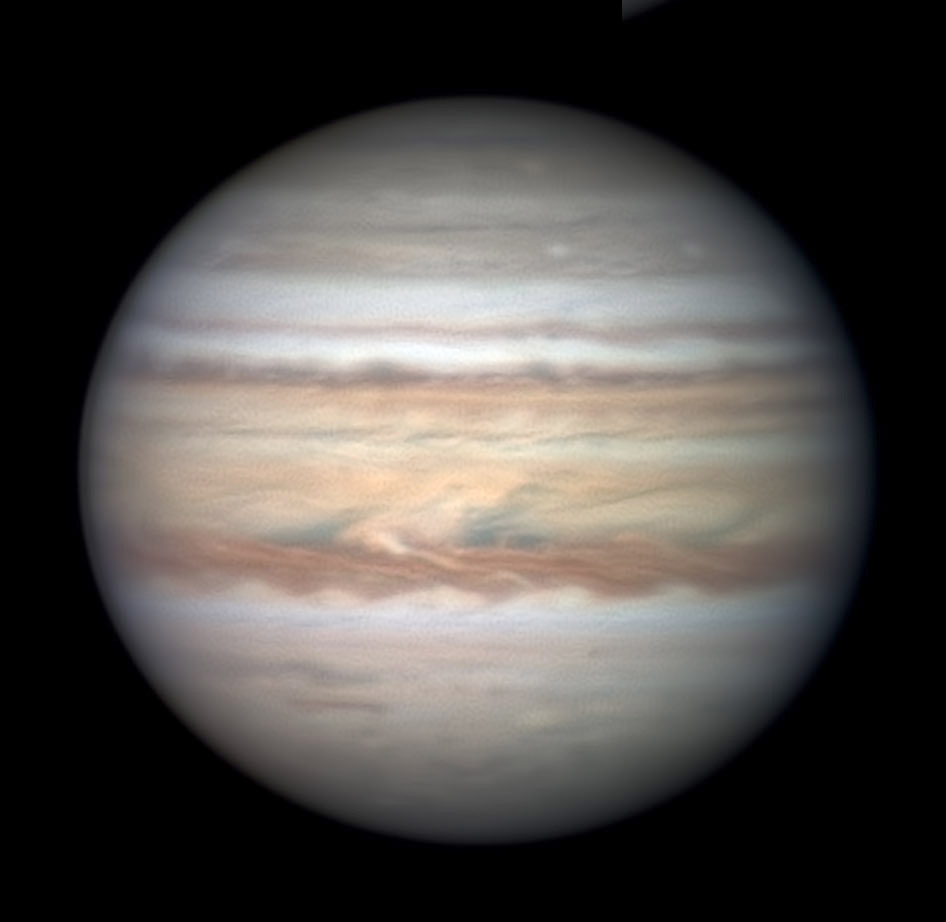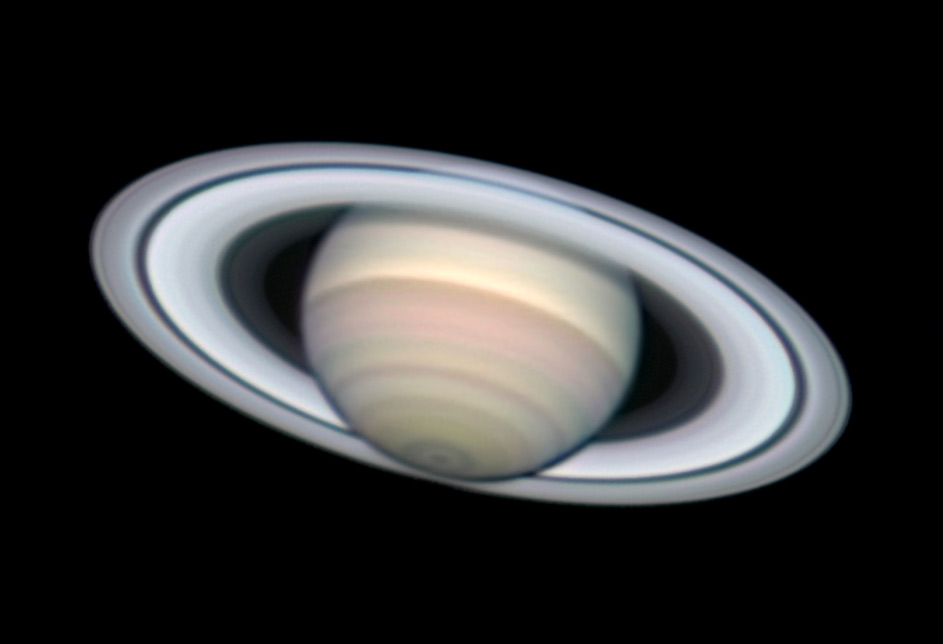
Friday, July 26
• The waning crescent Moon crosses Taurus for the next three mornings before dawn, as shown here. To catch the Pleiades and Aldebaran look at least 1½ hours before your own local sunrise time, no matter when that is.
Saturday, July 27
• The two brightest stars of summer are Vega, overhead soon after dark, and Arcturus, shining in the west. Draw a line down from Vega to Arcturus. A third of the way down, the line crosses the dim Keystone of Hercules. Two thirds of the way down it crosses the dim semicircle of Corona Borealis with its one modestly bright star, Alphecca or Gemma.
Vega and the Keystone's star closest to it form an equilateral triangle with Eltanin to their north, the nose of Draco the Dragon. Eltanin is the brightest star of Draco's quadrilateral head; he's forever eyeing Vega.
Sunday, July 28
• Important asteroid occultation late tonight. The asteroid 3200 Phaethon, parent object of the Geminid meteor shower, should occult a 7.3-magnitude star in Auriga 5° from Capella within a minute or so of 11:20 UT (4:20 a.m. PDT) Sunday morning along a narrow track from roughly Pismo Beach, California, to a little north of Las Vegas. Special page for this observing campaign with links to detailed map, finder charts, and full info. Video timings are needed, and expeditions are planned.
• After nightfall, Altair shines in the east-southeast. It's the second-brightest star on the eastern side of the sky, after Vega very high to its upper left. Above Altair by a finger-width at arm's length is little orange Tarazed.
A bit more than a fist-width to Altair's left or lower left is little Delphinus, the Dolphin, leaping leftward.
Above the midpoint between Altair and Delphinus is even fainter, smaller Sagitta, the Arrow.
Monday, July 29
• We're not yet halfway through summer, but already W-shaped Cassiopeia, a constellation of fall and winter evenings, is climbing up in the northeast as evening grows late. And the Great Square of Pegasus, emblem of fall, comes up to balance on one corner just over the eastern horizon.
Tuesday, July 30
• The tail of Scorpius is low due south right after dark. How low depends on how far north or south you live: the farther south, the higher.
Look for the two stars especially close together in the tail. These are Lambda and fainter Upsilon Scorpii, known as the Cat's Eyes. They're canted at an angle; the cat is tilting his head and winking.
The Cat's Eyes point west (right) by nearly a fist-width toward Mu Scorpii, a much tighter pair known as the Little Cat's Eyes. They're oriented almost exactly the same way as Lambda and Upsilon but are only one-sixth as far apart. Bring binoculars!
Wednesday, July 31
• Fourth star of the Summer Triangle. The next-brightest star near the Summer Triangle, if you want to turn it into a quadrilateral, is Rasalhague, the head of Ophiuchus. Face south soon after dark. You'll find Rasalhague about equally far right of Altair and lower right of Vega. Altair is the Summer Triangle's lowest star now. Vega, nearly overhead, is its brightest.
• New Moon (exact at 11:12 p.m. EDT)
Thursday, August 1
• The Sagittarius Teapot hangs in the south these evenings, to the lower right of Saturn. It's beginning to tilt to pour from its spout to the right. The Teapot will tilt further for the rest of the summer — and for much of the night if you stay out late.
• Today is Lammas Day or Lughnasadh, one of the four traditional "cross-quarter" days midway between the solstices and equinoxes. Sort of. The actual midpoint between the June solstice and the September equinox this year comes at 7:52 a.m. August 7th Eastern Daylight Time (11:52 UT). That is the exact center-balance of astronomical summer: the very height of the year. (Although the height of heat in the Northern Hemisphere generally comes earlier, in July.)

Friday, August 2
• Bright Vega passes closest to overhead around 11 p.m., depending on how far east or west you live in your time zone. How closely it misses your zenith depends on how far north or south you are. It passes right through your zenith if you're at latitude 39° north (Washington DC, Cincinnati, Kansas City, Lake Tahoe). How closely can you judge this just by looking?
Deneb crosses closest to the zenith almost exactly two hours after Vega.
Saturday, August 3
• The Big Dipper hangs diagonally in the northwest after dark. From its midpoint, look to the right to find Polaris (not very bright) glimmering due north as always.
Polaris is the handle-end of the Little Dipper. The only other parts of the Little Dipper that are even modestly bright are the two stars forming the outer end of its bowl. On August evenings you'll find them to Polaris's upper left (by about a fist and a half at arm's length). They're called the Guardians of the Pole, since they circle around Polaris throughout the night and throughout the year.
________________________
Want to become a better astronomer? Learn your way around the constellations. They're the key to locating everything fainter and deeper to hunt with binoculars or a telescope.
This is an outdoor nature hobby. For an easy-to-use constellation guide covering the whole evening sky, use the big monthly map in the center of each issue of Sky & Telescope, the essential guide to astronomy.

Once you get a telescope, to put it to good use you'll need a detailed, large-scale sky atlas (set of charts). The basic standard is the Pocket Sky Atlas (in either the original or Jumbo Edition), which shows stars to magnitude 7.6.
Next up is the larger and deeper Sky Atlas 2000.0, plotting stars to magnitude 8.5; nearly three times as many. The next up, once you know your way around, are the even larger Interstellarum atlas (stars to magnitude 9.5) and Uranometria 2000.0 (stars to magnitude 9.75). And read how to use sky charts with a telescope.
You'll also want a good deep-sky guidebook, such as Sue French's Deep-Sky Wonders collection (which includes its own charts), Sky Atlas 2000.0 Companion by Strong and Sinnott, or the bigger Night Sky Observer's Guide by Kepple and Sanner.
Can a computerized telescope replace charts? Not for beginners, I don't think, and not on mounts and tripods that are less than top-quality mechanically (meaning heavy and expensive). And as Terence Dickinson and Alan Dyer say in their Backyard Astronomer's Guide, "A full appreciation of the universe cannot come without developing the skills to find things in the sky and understanding how the sky works. This knowledge comes only by spending time under the stars with star maps in hand."
This Week's Planet Roundup
Mercury, Venus, and Mars remain out of sight in the glare of the Sun. Mercury will emerge into dawn view next week, but Venus and Mars are basically gone until October.

Jupiter (magnitude –2.4, between the legs of Ophiuchus) is the white point glaring in the south during and after dusk. Orange Antares, much fainter at magnitude +1.0, twinkles 7° to its lower right.
Jupiter and Antares form a shallow isosceles triangle with Delta Scorpii (Dschubba) to their right. Delta, a long-term eruptive variable of the Gamma Cassiopeiae type, hasn't been much fainter than Antares for most of the last 19 years — after it brightened by some 50%, without warning, in July 2000.
In a telescope Jupiter is still 43 arcseconds wide. See Bob King's observing guide to Jupiter.

In a telescope Saturn's rings are tilted a wide 24.7° to our line of sight.
Uranus (magnitude 5.8, in Aries) is high in the southeast before the first beginnings of dawn.
Neptune (magnitude 7.8, in Aquarius) is high in the south at that time. Finder charts for Uranus and Neptune.
_________________
All descriptions that relate to your horizon — including the words up, down, right, and left — are written for the world's mid-northern latitudes. Descriptions that also depend on longitude (mainly Moon positions) are for North America.
Eastern Daylight Time (EDT) is Universal Time (UT, UTC, GMT, or Z time) minus 4 hours.
_________________
Audio sky tour. Out under the evening sky with your earbuds in place, listen to Kelly Beatty's monthly podcast tour of the heavens above. It's free.
_________________
“This adventure is made possible by generations of searchers strictly adhering to a simple set of rules. Test ideas by experiments and observations. Build on those ideas that pass the test. Reject the ones that fail. Follow the evidence wherever it leads, and question everything. Accept these terms, and the cosmos is yours.”
— Neil deGrasse Tyson, 2014
______________________
 1
1








Comments
Rod
July 26, 2019 at 8:54 am
mary beth, I did enjoy some Jupiter and Saturn observing last night using my 90-mm refractor and 10-inch Newtonian. Jupiter retrograding in Ophiuchus is very close to globular cluster NGC 6235 last night and tonight (4 arcminute tonight). I could just barely detect using the 10-inch because of Jupiter's brightness, no stars resolved just faint, small fuzzy, Jupiter, cloud bands, and 4 Galilean moons visible. Saturn I enjoyed from 35x to 100x views. Many stars in Sagittarius visible all around in the field of view, especially at 35x and 1.8-degree true FOV - quite a sight. I could see Cassini division, cloud banding, and shading in north polar area of Saturn along with 4 Saturnian moons. After 10:30 PM, altocumulus clouds moved in and started making it difficult so I went back in near 11:30 PM EDT.
You must be logged in to post a comment.
You must be logged in to post a comment.